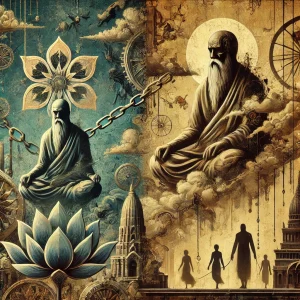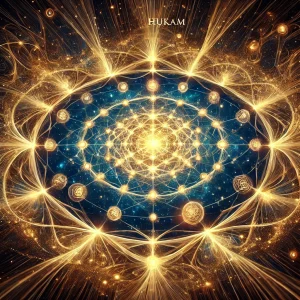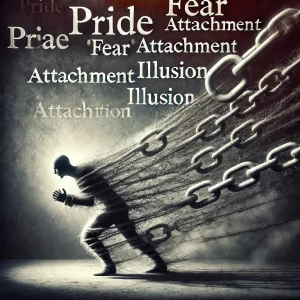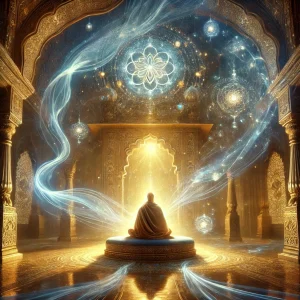Dzogchen and Gurmat (Guru Nanak): A Comparative Ontology of Consciousness, Practice, and Liberation 
Abstract
This paper offers a rigorous comparative study of Dzogchen (the Great Perfection of the Tibetan Buddhist Nyingma tradition) and Gurmat (Guru Nanak’s teaching as enshrined in the Sri Guru Granth Sahib). Both traditions articulate a nondual ground of reality, diagnose ego as the central obscuration, and prescribe direct means to realize innate luminosity. Yet their metaphysical language, soteriological emphasis, and social ethics diverge: Dzogchen privileges rigpa—the immediate recognition of primordial awareness—while Gurmat privileges Naam—resonant alignment with the One (Ik Ongkaar) through Shabad (Divine Word), Hukam (cosmic Order), Sangat (community), and Seva (service). We compare their accounts of the ground (gzhi vs. Ik Ongkaar), method (pointing‑out vs. grace‑infused Naam‑Simran), praxis (contemplative spontaneity vs. householder engagement), and death‑transition (bardos vs. ant kāl). We argue that Dzogchen and Gurmat are complementary ontologies of the Real: Dzogchen as apophatic recognition of clear‑light awareness; Gurmat as cataphatic resonance with the Divine Name.
Keywords: Dzogchen, rigpa, kadag, lhun grub, Guru Nanak, Gurmat, Ik Ongkaar, Naam, Hukam, Shabad, bardo, ant kāl, nonduality, householder path.
1) Orientation and Method
Comparative philosophy of religion can drift into superficial “same‑saying.” To avoid that, we (i) keep close to primary sources and canonical formulations, and (ii) compare at four levels: (a) Ontology (what is ultimately Real?), (b) Epistemology (how is it known?), (c) Praxis/Ethics (how is it lived?), and (d) Soteriology (what is liberation?). For Dzogchen, we rely on classical Nyingma sources (Longchen Rabjam/Longchenpa), authoritative modern expositions (e.g., Namkhai Norbu), and critical reference works. For Gurmat, we cite the Sri Guru Granth Sahib (SGGS) with ang (folio) references and standard digital concordances.
Load‑bearing references used in this paper include:
– Definitions of rigpa, kadag (primordial purity), and lhun grub (spontaneous presence). (rywiki.tsadra.org, rigpawiki.org)
– Dzogchen textual anchors (Longchenpa; the bardo literature and its modern critical framing). (librarycat.org, Oxford Research Encyclopedia)
– Core Gurmat lines: Mūl Mantra / Japjī opening; Hukam pauri; haumai (ego) diagnosis and remedy; and ant kāl teaching. (srigranth.org, SikhNet)

2) Historical Snapshots (Very Brief)
Dzogchen emerges in Tibet as the apex view/practice of the Nyingma school, thematized by Longchenpa (1308–1364) in the Seven Treasuries and elaborated in treasure (terma) cycles like Bardo Tödröl (Great Liberation through Hearing). The Oxford Research Encyclopedia clarifies the text family and modern translation history (e.g., Gyurme Dorje’s work). (Oxford Research Encyclopedia)
Gurmat originates with Guru Nanak (1469–1539) and continues through the ten Gurus, culminating in the SGGS as the Shabad‑Guru. The Mūl Mantra and Japjī Sahib (Ang 1–8) formulate the ground (Ik Ongkaar), the role of Hukam, and the path of Naam. (srigranth.org)
3) Ontology: The Ground of Being
Dzogchen: the Ground (gzhi), Rigpa, and Its Twofold Aspect
Dzogchen describes the primordial ground as already complete—empty in essence (kadag) and dynamically expressive as spontaneous presence (lhun grub). The immediate, reflexive knowing of this ground is rigpa. Rangjung Yeshe’s dharma dictionary and Rigpa‑aligned references consistently gloss kadag as “primordial purity” and lhun grub as “spontaneous presence,” the two inseparable facets of rigpa’s reality‑mode. (rywiki.tsadra.org, rigpawiki.org)
Gurmat: Ik Ongkaar, Naam, and Hukam 
Guru Nanak opens with the Mūl Mantra: One Reality (Ik Ongkaar), Truth as Name (Sat Naam), Formless‑Timeless, unborn, self‑existent—known by the Guru’s grace. The very next movement insists: “Aad sach, jugad sach; hai bhi sach, Nanak hosi bhi sach”—the Real is true before time, through time, now, and forever (SGGS Ang 1). (srigranth.org)
Hukam (cosmic Order) is not mechanical determinism; it is the ontological Law/Intelligence by which forms arise. “Hukam rajāī chalṇā, Nanak likhiā nāl”—to become true is to move in consonance with Hukam (Ang 1). Naam is the vibrational signature—the “Name” that is both pointer and presence of the One; Shabad is its revelatory wave‑form through which the Guru (as Shabad‑Guru) awakens alignment. (srigranth.org)
Interim synthesis: Dzogchen’s ground is described apophatically (emptiness/luminosity), while Gurmat describes it cataphatically as the One whose Naam resounds through Hukam. Both insist the Real is immediately present and self‑revealing.
4) The Obscuration Problem: Ego and Ignorance 
Dzogchen
The obscuration is ma‑rigpa (unawareness), the failure to recognize rigpa. Conceptually, thoughts are like clouds veiling the sky (rigpa). When rigpa recognizes itself, the clouds self‑liberate. (See the rigpa/ma‑rigpa distinction in standard Dzogchen expositions.) (Wikipedia)
Gurmat
The obscuration is haumai—the egoic “I‑I” vibration that distorts resonance with the One. SGGS calls haumai a “deep disease,” yet says its remedy lies within—through Shabad and grace: “Haumai dīragh rog hai, dārū bhī is māhi; kirpā kare je āpṇī, tā gur kā shabad kamāhi” (Ang 466). Gurmat also states: “Haumai nāvai nāl virodh hai, duae na vaseh ik thāe”—ego and Naam cannot co‑inhabit the same “place” (consciousness‑field) (Ang 560/931 traditions); the remedy is living the Guru’s Shabad so Naam abides. (srigranth.org, SikhNet)
Interim synthesis: Both traditions agree the fundamental “pathology” is mis‑attunement: ma‑rigpa in Dzogchen, haumai in Gurmat.
5) Epistemology and Method: How Realization Happens 
Dzogchen’s Direct Introduction
Pointing‑out instruction introduces the student directly to rigpa—immediate, non‑conceptual recognition (ngo sprod). Thereafter, practice is essentially to remain as rigpa, with two archetypal vectors:
Trekchö (“cutting through”): relaxation into the primordial purity (kadag).
Thögal (“leaping over”): visionary integration of spontaneous presence (lhun grub), classically linked to clear‑light phenomenology and the fruition known as “rainbow body” in hagiography. (Wikipedia)
Gurmat’s Grace‑Infused Immersion in Naam
Gurmat is radically participatory. One aligns to the Real by immersing consciousness in Naam (Naam‑Simran), internalizing Shabad, participating in Sangat, and serving through Seva—all under the arc of Nadar (grace). The existential “method” is to live Hukam: the Japjī asks “Kiv sachiarā hoīai?”—“How do we become true?”—and answers “Hukam rajāī chalṇā” (Ang 1). Living the answer—breath‑to‑breath—is epistemology as embodied resonance. (srigranth.org)
Interim synthesis: Dzogchen operationalizes recognition; Gurmat operationalizes resonance. Both are immediate and grace‑touched, but Dzogchen accents non‑doing, while Gurmat binds knowing to loving service and ethical action.
6) Praxis and Ethics: From Cushion to Community 
Dzogchen’s Spontaneous Compassion
In classical presentation, ethical expression (bodhicitta) is the spontaneous outflow of rigpa’s recognition—compassionate energy that is inseparable from the ground’s luminosity. Formal vows and disciplines may frame practice, but the hallmark is effortless responsiveness born of non‑clinging awareness.
Gurmat’s Householder Dharma
Gurmat explicitly rejects world‑denial. The world (kudrat) is the play of the One. The archetypal practitioner is a grisht (householder): earn honestly, remember Naam, and serve. The litmus of realization is Seva (service), Sangat (community), and kirat karṇī (ethical livelihood). In Gurmat, devotion and justice are not add‑ons but constitutive of awakened life.
Interim synthesis: Dzogchen leans toward contemplative non‑fabrication; Gurmat bends toward active non‑separation—awareness‑as‑care in society.
7) Language and Phenomenology: Silence and Sound
Dzogchen speaks apophatically: emptiness, clear light, kadag/lhun grub. Phenomenology often uses sky/sun/cloud metaphors; the experiential tone is wordless immediacy.
Gurmat speaks cataphatically: Naam (Name/Sound‑Presence), Shabad (Word), Naad (cosmic tone), Jot (Light), Hukam (Order). Phenomenology is sonic‑luminous; the experiential tone is resonant remembrance. Japjī’s opening couples metaphysical declaration with a practical question and a lived answer—Hukam.
8) Death and Liberation: Bardos and Ant Kāl 
Dzogchen’s Bardos
The bardo literature (Bardo Tödröl, “Great Liberation through Hearing”) instructs recognition of clear light at death and during intermediate states. Modern scholarship clarifies its compilation/translation history and its role in ritual guidance. (Oxford Research Encyclopedia)
Gurmat’s Ant Kāl Teaching
Gurmat emphasizes the state of mind at the last moment (ant kāl): we “go where we dwell.” Bhagat Trilochan’s celebrated shabad (SGGS Ang 526) warns: fixation on wealth, sex, progeny, or mansions conditions post‑mortem trajectory; remembrance of the Divine liberates—hence the primacy of Naam‑soaked living long before death. (SikhNet)
Interim synthesis: Dzogchen optimizes recognition across bardos; Gurmat optimizes resonant living such that ant kāl naturally flowers in Naam.
9) Comparative Table (compact)
| Axis | Dzogchen | Gurmat (Guru Nanak) |
| Ground | Primordially pure, spontaneously present ground recognized as rigpa (kadag/lhun grub). (rywiki.tsadra.org, rigpawiki.org) | Ik Ongkaar (One Reality), Sat Naam; the world unfolds by Hukam; realized by Naam through Guru’s grace. (srigranth.org) |
| Obscuration | Ma‑rigpa (unawareness) | Haumai (ego‑frequency) as “deep disease,” cured by Shabad under grace. (srigranth.org) |
| Method | Direct introduction and abiding as rigpa (trekchö, thögal). (Wikipedia) | Naam‑Simran, Shabad‑Dhyan, Seva, Sangat; Hukam rajāī chalṇā. (srigranth.org) |
| Ethic | Spontaneous bodhicitta as expression of rigpa. | Householder dharma; justice, seva, truthful living as expression of Naam. |
| Death | Bardo recognition and guidance. (Oxford Research Encyclopedia) | Ant kāl: last‑moment awareness tracks lifetime resonance; Naam ensures liberation. (SikhNet) |
| Key Tension | Emphasis on apophatic recognition | Emphasis on cataphatic resonance |
10) Convergences and Divergences
Deep Convergences
Nonduality of the Real: Both traditions assert an ever‑present ground that is self‑revealing.
Ego as Pathology: Ma‑rigpa / haumai articulate the same problem—misrecognition/mis‑resonance. (SGGS explicitly names haumai as disease and prescribes Shabad/Naam as cure.) (srigranth.org)
Grace: Even in Dzogchen, the master’s pointing‑out functions as grace; in Gurmat, nadar is explicit in the very grammar of the Mūl Mantra (“known by the Guru’s grace”) and in the remedy for haumai. (srigranth.org)
Defining Divergences
Metaphysical Language: Dzogchen speaks in a via negativa of emptiness‑luminosity; Gurmat sings a via positiva of Naam‑Hukam‑Jot.
Soteriological Texture: Dzogchen privileges recognition now (resting as rigpa); Gurmat binds realization to ethical participation (Naam‑infused living, kirat, vand chhaknā, seva).
Social Form: Dzogchen can thrive in contemplative seclusion; Gurmat is inherently communal and householder‑centric.
Deathwork: Dzogchen systematizes bardo protocols; Gurmat emphasizes lifelong preparation so that ant kāl is already Naam.
11) Implications for Gurmat Psychology
For a Gurmat‑framed psychology of consciousness:
Ontological coherence: Treat Naam as the operative signature of nondual consciousness, akin to Dzogchen’s rigpa, but expressed through sonic‑ethical resonance (Shabad/Hukam).
Ego work: The haumai diagnosis aligns with Dzogchen’s ma‑rigpa; techniques that promote non‑reactivity (awareness of awareness) can be integrated with Naam‑Simran to expedite de‑identification from selfing narratives.
Community and regulation: Sangat provides a coherence field—affective, ethical, and acoustic—that stabilizes realization in daily life, a dimension less foregrounded in solitary contemplative models.
End‑of‑life care: Dzogchen’s bardo literacy can inform Gurmat palliative practices—without supplanting the centrality of Naam at ant kāl.
12) Worked Hermeneutic: Reading Two Signature Passages 
Dzogchen Lens
Longchenpa’s Precious Treasury of the Way of Abiding repeatedly explicates the already‑accomplished nature of the ground and the need to relax effort into what is self‑perfected (lhun grub). This is not quietism but recognition—the heart of Dzogchen soteriology. (librarycat.org)
Gurmat Lens
The Japjī opening (Ang 1) establishes ontological stability (“True before time, through time, now, forever”) and pivots to the method: “Hukam rajāī chalṇā”. Elsewhere, SGGS diagnoses the disease (haumai) and prescribes the cure (Shabad under grace), making the path unmistakably practical. (srigranth.org)
13) A Subtle Convergence: Sound and Light
Light metaphors saturate both traditions (Dzogchen’s clear light; Gurmat’s Jot). Sound is foregrounded in Gurmat (Naam, Shabad, Naad) but is present in Dzogchen too (the seed ‘A’ as symbol of kadag, visionary mantric dimensions of thögal). One might say: Dzogchen listens to the silence of light; Gurmat sings the light of sound.
14) Limits and Complementarities
If one absolutizes apophatic silence, ethics can seem secondary; Gurmat corrects by welding awareness to justice and service.
If one absolutizes devotional resonance without insight, praxis can reify concepts of God; Dzogchen corrects by insisting on non‑conceptual recognition.
Together, they sketch a bi‑lensed nonduality: recognition (rigpa) and resonance (Naam).
15) Conclusion
Dzogchen and Gurmat are not two roads to two places; they are two languages of one nondual immediacy. Dzogchen articulates the already pure and spontaneously present ground—recognized directly as rigpa—and trusts spontaneous compassion to flow. Gurmat articulates the One whose Naam resounds through Hukam, and it binds realization to life—work, community, service, and remembrance—so that at ant kāl the heart is already Naam. For practitioners and scholars, the two together offer a complete ecology of awakening: apophatic clarity married to cataphatic love—silence aware of itself and sound singing itself home.
Notes & Citations (select)
Rigpa / Kadag / Lhun grub: Definitions and doctrinal framing. (rywiki.tsadra.org, rigpawiki.org)
Dzogchen fruition & togal imagery (“rainbow body”): overview and modern summaries. (Wikipedia)
Bardo corpus & modern scholarship (translation history/context): (Oxford Research Encyclopedia)
Longchenpa, Precious Treasury of the Way of Abiding (Seven Treasuries; authoritative translation metadata). (librarycat.org)
Gurmat core lines:
“Aad sach, jugad sach; hai bhi sach, Nanak hosi bhi sach” (SGGS Ang 1). (srigranth.org)
Hukam pauri in Japjī (SGGS Ang 1). (srigranth.org)
“Haumai dīragh rog hai, dārū bhī is māhi …” (SGGS Ang 466). (srigranth.org)
“Haumai nāvai nāl virodh hai …” (SGGS—attested in standard concordances). (SikhNet)
Ant kāl shabad (Bhagat Trilochan, SGGS Ang 526). (SikhNet)
(c) 2025 D S Panesar
Gurmat Psychology Series
